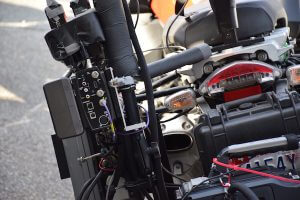BY ART COLLINS
For the last 23 years I’ve been a part of the team that provides live coverage of the Boston Marathon. From the starting line to the finish line, we follow the runners and transmit live footage by microwave to local and national stations. While usually reliable, microwave signals are susceptible to interference from weather and other atmospheric conditions. We prefer to send redundancy footage whenever possible.

Comrex LiveShot, hooked up to a motorcycle to cover the Boston Marathon.
The Boston Marathon course is unique in the racing world. It’s a straight line that cuts across 26 miles of hilly terrain, and reception is patchy at many points. We understood that potentially losing reception was a vulnerability of using cell service.
We initially explored bonded cellular as a redundancy tool for our marathon broadcast. During our testing, Comrex LiveShot was the most reliable option for us. We attached portable units to the back of several cameras, then mounted those cameras to motorcycles and pickup trucks that followed the runners during the race. We were able to test ahead of time and verify that we had signal throughout the course.
We used both Verizon and AT&T modems. Because of our testing, we knew exactly where the networks would change over on the course, and LiveShot handled the network shifting beautifully. LiveShot provided an excellent backup feed for us, and the technology worked very well in these demanding conditions.
Learn how LiveShot works!
Have questions? Send us an email!
Want to try LiveShot? Request a demo.
Looking to buy? Find an authorized dealer.
This user report was originally published in Creative Planet Network. You can view it here.
Arthur Collins is a freelance television engineer and director of media services for Mount Wachusett Community College.
